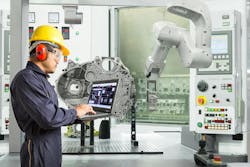How Edge Computing can Give OEMs a Competitive Advantage
Just a few years ago, it seemed like everyone in the warehouse automation industry was talking about cloud computing. The next generation of sortation equipment was going to send all its data through the internet. Fancy algorithms and human experts would analyze it in real time, responding with alerts and advice if anything was about to go wrong.
More recently, this utopian vision has run up against two major obstacles:
- The cloud isn’t free. Worse, the more data you send through it, the more expensive it becomes.
- Your customers are sensitive about their operational data.
Cloud computing was touted as a way to enable sophisticated analyses that were too complex to be performed in-house. As the pendulum swings the other way, however, a new model known as “edge” computing has emerged.
In this article, we’ll explore what edge computing is and how it’s helping OEMs and integrators to create sortation systems that deliver on many of the promises of cloud computing without leaving the “safe” confines of customer networks.
Calculate Locally with Edge Computing
The broad category of edge computing refers to applications that bring calculation power closer to the end user — built into individual components or hosted on an internal system. Instead of being housed in the cloud, processing power is at the “edge” of the user’s network. Computations are performed on physical equipment at or near data sources like sensors, internet of things (IoT) devices, or local servers. In some cases, no internet connection is required.
The advantage that’s most often mentioned is speed. Even with a lightning-fast internet connection, it can take a few seconds for a local device to get a response from a cloud-based server. This network delay, known as latency, can be even longer if you’re in a remote location or transmitting complex information.
If you’ve ever tried to dictate a text message to your smartphone, you’ve experienced a latency delay. Although those extra milliseconds may not seem very long, you wouldn’t want that much lag time from a self-driving vehicle, multiplayer video game, or robotic-assisted surgery.
Latency matters in warehouse automation too. Performing predictive maintenance on a shoe sorter, for example, could require real-time monitoring of actuators that do diversions every 40 milliseconds. Component-level computing power allows the system to respond to changing conditions with speed and efficiency levels that simply wouldn’t be possible with a cloud-based system.
Data privacy is another advantage of edge computing that resonates strongly with end users. They’ll tell you they’re not interested in cloud computing because they’re worried about hackers getting access to proprietary data or trade secrets. But what they won’t tell you is that they don’t want you watching how they use your equipment either.
Recent scares like the CrowdStrike incident have highlighted a further weakness of cloud computing: what do you do if critical central servers go down?
The market has made its wishes clear: what happens in-house needs to stay in-house.
Embedded Computing Enables Component-Level Calculations
Components and subcomponents with built-in computing power are becoming key drivers for edge computing capabilities in warehouse automation. Embedded microprocessors make solenoids, motorized drive rollers (MDRs), steerable wheel table modules, and other components smarter.
For example, Solligence fast rotary actuators continuously monitor changes in motion duration, adjusting the drive profile as needed to continue meeting or exceeding performance specifications.
Edge components can also communicate with a system’s programmable logic controllers (PLCs), making their data immediately available to end users. Supporting software on the customer’s local network interprets this information, enabling predictive maintenance and other real-time insights while tracking historical trends over time.
Users can immediately tell whether the system is running smoothly, experiencing downtime, or developing an issue that risks becoming a virtual time bomb. Nothing is transmitted outside the customer’s IT ecosystem.
Edge Computing Allows for Smarter and Longer Lasting Component Designs
Edge technology enables you to build assets that deliver higher utilization to your customers. Much of this benefit comes from the greater efficiencies of predictive maintenance. Users have less downtime because unnecessary service is reduced or eliminated, and many problems can be resolved before they cause unplanned shutdowns.
Smart components can also deliver more process consistency. Ordinarily, parts degrade over time, gradually losing speed and/or power. With edge capabilities, they can continuously adapt to changing conditions, including varying parcel weights and normal wear. The technology is precise enough to reliably model a system’s long-term behavior.
For example, with Solligence fast rotary actuators, these benefits increase throughput by boosting uptime and maintaining the same performance after 50 million cycles that they had provided when the system was commissioned.
OEMs and Customers Alike Benefit from Edge Computing
The advantages your customers can derive from edge computing aren’t just good for them — they’re also great for you. Leading original equipment manufacturers (OEMs) are already leveraging the capabilities of component-level computing power into branded offerings that differentiate them from competitors. You’ll also be able to offer advanced capabilities without the uphill battles needed to calm data privacy concerns.
The proven successes of component-level computing are just the “edge” of the iceberg. The measurable efficiency and throughput advantages they offer are truly exciting.
This article was written and contributed by Vincent Sallé, Vice President of Business Development at Johnson Electric.
About the Author
Vincent Sallé
Vice President of Business Development, Johnson Electric
Vincent Sallé is Vice President of Business Development at Johnson Electric. He has been with the company since 2001 and has occupied various positions in Marketing, Program Management, Sales, Business Development and General Management. He has worked for Johnson Electric around the world, including China, Hong Kong, France, UK and USA. Sallé enjoys working with customers in identifying problems and finding the right solutions, leading to the creation of new product lines.

Leaders relevant to this article:


